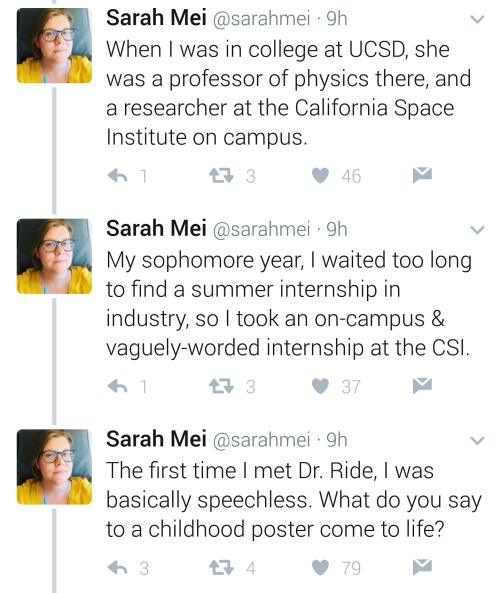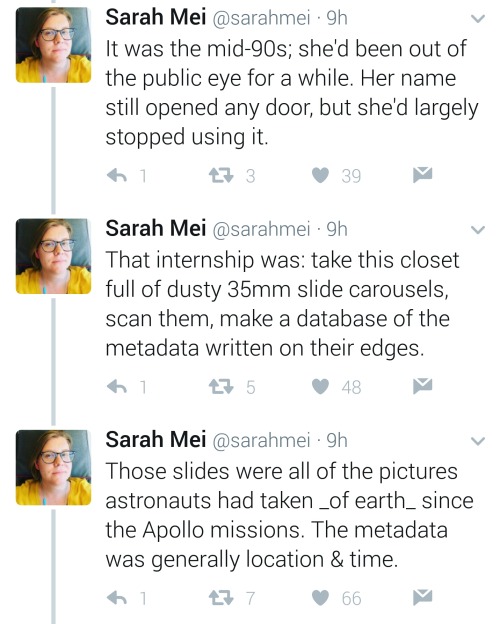Fillthevoid-with-space - Fill The Void With... SPACE

More Posts from Fillthevoid-with-space and Others
The United Launch Alliance’s Atlas V rocket carrying the Orbital ATK Cygnus module rolls to Cape Canaveral Air Force Station’s Launch Pad 41 in this time-lapse video. The rollout is in preparation for the Orbital ATK CRS-7 mission to deliver supplies to the International Space Station.
Launch is currently scheduled for 11:11 a.m. EDT, watch live coverage: http://www.nasa.gov/live
Make sure to follow us on Tumblr for your regular dose of space: http://nasa.tumblr.com










Equal opportunity benefits can be far-reaching
https://twitter.com/sarahmei/status/818682610712866817

Inner corona and prominences during Monday’s total solar eclipse
via reddit

In the Heart of the Virgo Cluster : The Virgo Cluster of Galaxies is the closest cluster of galaxies to our Milky Way Galaxy. The Virgo Cluster is so close that it spans more than 5 degrees on the sky - about 10 times the angle made by a full Moon. With its heart lying about 70 million light years distant, the Virgo Cluster is the nearest cluster of galaxies, contains over 2,000 galaxies, and has a noticeable gravitational pull on the galaxies of the Local Group of Galaxies surrounding our Milky Way Galaxy. The cluster contains not only galaxies filled with stars but also gas so hot it glows in X-rays. Motions of galaxies in and around clusters indicate that they contain more dark matter than any visible matter we can see. Pictured above, the heart of the Virgo Cluster includes bright Messier galaxies such as Markarians Eyes on the upper left, M86 just to the upper right of center, M84 on the far right, as well as spiral galaxy NGC 4388 at the bottom right. via NASA
js
Until I get this show rolling, I’m going to be posting some of the things I’ve collected over the years that might make for interesting things to do podcasts about down the line!

After over a century of observations and several theories, scientists may have finally nailed the origin of the high-speed plasma blasting through the Sun’s atmosphere several times a day. Using a state-of-the-art computer simulation, researchers have developed a detailed model of these plasma jets, called spicules.
The new findings answer some of the bigger questions in solar physics, including how these plasma jets form and why the Sun’s outer atmosphere is far hotter than the surface.
“This is the first model that has been able to reproduce all the features observed in spicules,” Juan Martinez-Sykora, lead author and astrophysicist at the Bay Area Environmental Research Institute in California, told ScienceAlert.
Continue Reading.

Did you know that some observatories are not on the ground and not orbiting Earth, but are mounted on airplanes? I finally researched SOFIA, an infrared observatory in a repurposed plane, and discovered there’s a rich history of airborne astronomy. And by airborne astronomy, I mean a lot of people took pictures of astronomical phenomena from planes!
Below the cut, I have the glossary, transcript, sources, and music credits. If you have suggestions for topics I could cover, please send me a Tumblr message or tweet at me on Twitter at @HDandtheVoid, or you can ask me to my face if you know me. Please subscribe on iTunes, rate my podcast and maybe review it, and tell friends if you think they’d like to hear it!
(My thoughts on the next episode are Chuck Yeager, Stephen Hawking and his theories, the opposition of Mars, famous comets, recent developments and discoveries in the astronomer community, or an atmospheric phenomenon called ‘Steve.’ The next episode will go up April 30th, lord willing and the creek don’t rise!)
Glossary
absorption bands - the areas of the electromagnetic spectrum that are absorbed by atmospheric gases.
atmospheric windows - the areas of the electromagnetic spectrum where the atmosphere is transparent, or does not absorb the radiation of specific wavelengths.
corona - the hot outer atmosphere of the Sun.
electromagnetic spectrum - the range of wavelengths or frequencies over which electromagnetic radiation extends. A photon transmits electromagnetic radiation at different frequencies, which are in a range that includes (from highest frequency to lowest) gamma rays, X-rays, ultraviolet light, visible light, infrared, microwaves, and radio waves
frequency - the number of times a wave oscillates up and down per second.
hypoxia - insufficient oxygen in the blood. Symptoms include vertigo, nausea, weakness, hyperventilation, slowed thinking, poor coordination, dimmed vision, and increased heart rate.
photon - a type of elementary particle that moves in a wave. It transmits electromagnetic radition such as light. The more energy a photon has, the higher its frequency.
Script/Transcript
Sources
A map of every active satellite orbiting Earth via Quartz
Infrared radiation via Gemini Observatory (Feb 1999)
Absorption Bands and Atmospheric Windows via NASA
Gladys Ingle of the 13 BLACK CATS changes planes in mid-air via YouTube
Milestones in Airborne Astronomy: From the 1920's to the Present by Wendy Whiting Dolci (1997)
Limits to human performance: elevated risks on high mountains, by Huey, Raymond B. and Xavier Eguskitza. Journal of Experimental Biology (2001)
When Humans Fly High by Linda Pendleton (Nov 1999)
Dalton's Law tells us that the total pressure of any mixture of gases (with constant temperature and volume) is the sum of the individual pressures (also called partial pressure) of each gas in the mixture. Also, partial pressure of each gas is proportional to that gas's percentage of the total mixture. Because the percentage of oxygen in the atmosphere remains constant at 21%, Dalton's Law lets us calculate the partial pressure of the oxygen in the atmosphere at any altitude. As we'll see shortly, the human body is affected by the pressure of the gases in the atmosphere. The partial pressure of oxygen (and to a lesser extent other gases) available in the surrounding air is important in determining the onset and severity of hypoxia.
Henry's Law states that the amount of gas dissolved in a solution is proportional to the partial pressure of the gas over the solution. A bottle of carbonated liquid demonstrates Henry's Law. When the bottle is uncapped, the carbon dioxide (CO2) in the mixture will slowly diffuse to the atmosphere until the pressure of CO2 in the liquid equals the pressure of CO2 in the surrounding air. The soda will then be "flat." A bottle of soda opened in an unpressurized aircraft at 10,000 feet will foam and overflow. The opposite will happen with soda opened at pressures greater than one atmosphere. A champagne cork won't pop in a diving bathysphere pressurized for deep ocean exploration.
Boyle's Law states that the volume of a gas is inversely proportional to the pressure on the gas as long as the temperature remains constant. A gas will expand when the pressure on it is decreased. This law holds true for all gases, even those trapped in body cavities. A volume of gas at sea level pressure will expand to approximately twice its original volume at 18,000 feet, nearly nine times its original volume at 50,000 feet.
Graham's Law tells us that a gas at higher pressure exerts a force toward a region of lower pressure. There's a permeable or semi-permeable membrane separating the gases, and gas will diffuse across the membrane from the higher pressure to the lower pressure. This will continue until the pressure of the gas is equal, or nearly equal, on both sides of the membrane. Graham's Law is true for all gases and each gas in a mixture behaves independently. It's possible to have two or more gases in a solution diffusing in opposite directions across the same membrane and, in fact, this is what happens to make oxygen transfer possible in the cells and tissues of the human body.
High-Altitude Hypoxia via Harvard (July 2012)
Kuiper Airborne Observatory via NASA (May 2005)
NASA's Kuiper Airborne Observatory via YouTube
SOFIA Science Center
Up all Night with SOFIA, NASA's Flying Observatory via YouTube
Intro Music: ‘Better Times Will Come’ by No Luck Club off their album Prosperity
Filler Music: ‘A Bite Out of My Bed’ by The New Pornographers off their album Together.
Outro Music: ‘Fields of Russia’ by Mutefish off their album On Draught
It made it!

Thank you SpaceX. You just gave us the keys to our dreams. So much is now possible…
(Image credit: SpaceX SES-10 stream)
-
 fillthevoid-with-space reblogged this · 8 years ago
fillthevoid-with-space reblogged this · 8 years ago -
 mini-space-alien-blog liked this · 9 years ago
mini-space-alien-blog liked this · 9 years ago -
 gagliandi liked this · 9 years ago
gagliandi liked this · 9 years ago -
 letsfollowthesedays liked this · 9 years ago
letsfollowthesedays liked this · 9 years ago -
 like-gossamer reblogged this · 9 years ago
like-gossamer reblogged this · 9 years ago
A podcast project to fill the space in my heart and my time that used to be filled with academic research. In 2018, that space gets filled with... MORE SPACE! Cheerfully researched, painstakingly edited, informal as hell, definitely worth everyone's time.
243 posts

